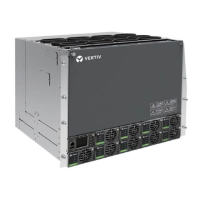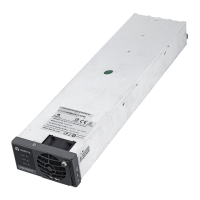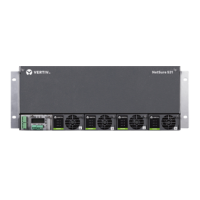Do you have a question about the Vertiv Liebert APM 400 and is the answer not in the manual?
Instructions for safe operation and handling by qualified professionals.
Guidelines on product usage, environment, and handling of potential hazards.
Manufacturer's liability limitations regarding product use and modifications.
Explanation of safety symbols and important warnings for users.
Details on UPS compliance with relevant European and international standards.
Information on managing multiple power sources and general safety guidelines for users.
Introduction to the Liebert APM UPS, its features, and design for data centers.
Covers site selection, ambient temp, ventilation, cleanliness, storage, and clearance.
Lists commonly used tools required for UPS installation and maintenance procedures.
Step-by-step guide for safely unpacking the UPS and battery units.
Ensuring the site is prepared and verifying UPS label for completeness and correctness.
Procedures for moving the cabinet and installing/removing power modules safely.
Diagrams showing dimensions and installation details of the UPS system.
Covers system configuration, cable sizing, protection, and terminal connections.
Details on communication ports like RS232, Dry Contact, EPO, and Intellislot.
Details on the panel layout, LED indicators, audible alarms, and control keys.
Explains LCD types, screen navigation, and detailed menu item descriptions.
Explains design concept, system design, and bypass operation principles.
Covers the function of power switches and step-by-step UPS startup procedures.
Describes how to transfer between different operating modes like Normal, Battery, and Bypass.
Procedures for performing battery tests and shutting down the UPS system.
Instructions for activating EPO, resetting the UPS, and handling automatic restart.
Guides on selecting language, changing date/time, and managing passwords.
Provides general information on battery strings and essential safety measures.
Details on battery types, installation safety, and environment considerations.
Covers general principles, installation steps, preliminary checks, and cabinet setup.
Details on external protection devices and power cable specifications for parallel systems.
Instructions for connecting parallel cables and using the remote EPO function.
Covers startup, maintenance bypass, isolation, re-insertion, and shutdown procedures.
Describes the installation of LBS systems with multiple UPS modules for dual bus configurations.
Overview of optional parts and installation for the battery temperature sensor kit.
Installation of inductors to ensure bypass output load sharing for parallel systems.
Details on installing IS-Unity-DP and IS-UNITY-LIFE cards for communication.
Information on IS-Relay card for alarms and LBS adapter for synchronization.
Details on pre-requisites and procedures for servicing power and bypass modules.
Information on component lifespan, replacement intervals, and air filter replacement.
Common maintenance tasks to prolong UPS service life, including cleaning and wiring checks.
Details on UPS compliance with European and international safety and EMC standards.
Specifies noise, altitude, humidity, and operating/storage temperature ranges.
Provides dimensions, weight, and protection rating for the UPS units.
Details input voltage, frequency, power factor, current, and harmonic distortion.
Specifies battery bus voltage, charging current, float/boost voltage, and EOD voltage.
Details output voltage, frequency, power factor, overload, and stability specifications.
Specifies bypass input voltage, current, frequency tolerance, and fuse requirements.
Information on heat dissipation in normal and ECO modes.
Definitions of technical terms used throughout the UPS manual.
Details on hazardous substances present in UPS components and environmental compliance.
Instructions for safe operation and handling by qualified professionals.
Guidelines on product usage, environment, and handling of potential hazards.
Manufacturer's liability limitations regarding product use and modifications.
Explanation of safety symbols and important warnings for users.
Details on UPS compliance with relevant European and international standards.
Information on managing multiple power sources and general safety guidelines for users.
Introduction to the Liebert APM UPS, its features, and design for data centers.
Covers site selection, ambient temp, ventilation, cleanliness, storage, and clearance.
Lists commonly used tools required for UPS installation and maintenance procedures.
Step-by-step guide for safely unpacking the UPS and battery units.
Ensuring the site is prepared and verifying UPS label for completeness and correctness.
Procedures for moving the cabinet and installing/removing power modules safely.
Diagrams showing dimensions and installation details of the UPS system.
Covers system configuration, cable sizing, protection, and terminal connections.
Details on communication ports like RS232, Dry Contact, EPO, and Intellislot.
Details on the panel layout, LED indicators, audible alarms, and control keys.
Explains LCD types, screen navigation, and detailed menu item descriptions.
Explains design concept, system design, and bypass operation principles.
Covers the function of power switches and step-by-step UPS startup procedures.
Describes how to transfer between different operating modes like Normal, Battery, and Bypass.
Procedures for performing battery tests and shutting down the UPS system.
Instructions for activating EPO, resetting the UPS, and handling automatic restart.
Guides on selecting language, changing date/time, and managing passwords.
Provides general information on battery strings and essential safety measures.
Details on battery types, installation safety, and environment considerations.
Covers general principles, installation steps, preliminary checks, and cabinet setup.
Details on external protection devices and power cable specifications for parallel systems.
Instructions for connecting parallel cables and using the remote EPO function.
Covers startup, maintenance bypass, isolation, re-insertion, and shutdown procedures.
Describes the installation of LBS systems with multiple UPS modules for dual bus configurations.
Overview of optional parts and installation for the battery temperature sensor kit.
Installation of inductors to ensure bypass output load sharing for parallel systems.
Details on installing IS-Unity-DP and IS-UNITY-LIFE cards for communication.
Information on IS-Relay card for alarms and LBS adapter for synchronization.
Details on pre-requisites and procedures for servicing power and bypass modules.
Information on component lifespan, replacement intervals, and air filter replacement.
Common maintenance tasks to prolong UPS service life, including cleaning and wiring checks.
Details on UPS compliance with European and international safety and EMC standards.
Specifies noise, altitude, humidity, and operating/storage temperature ranges.
Provides dimensions, weight, and protection rating for the UPS units.
Details input voltage, frequency, power factor, current, and harmonic distortion.
Specifies battery bus voltage, charging current, float/boost voltage, and EOD voltage.
Details output voltage, frequency, power factor, overload, and stability specifications.
Specifies bypass input voltage, current, frequency tolerance, and fuse requirements.
Information on heat dissipation in normal and ECO modes.
Definitions of technical terms used throughout the UPS manual.
Details on hazardous substances present in UPS components and environmental compliance.
| Product Type | Uninterruptible Power Supply (UPS) |
|---|---|
| Power Rating | 400 kVA / 400 kW |
| Phase | 3-phase |
| Frequency | 50/60 Hz |
| Efficiency | Up to 96% |
| Topology | Double Conversion Online |
| Input Voltage | 380/400/415 VAC |
| Output Voltage | 380/400/415 VAC |
| Cooling | Forced Air |
| Form Factor | Modular |
| Operating Temperature | 0°C to 40°C |
| Humidity Range | 0% to 95% non-condensing |









